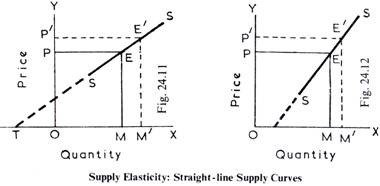A vertical straight line will represent absolutely inelastic supply (zero elasticity) and a horizontal straight line an infinitely elastic supply.
In between these two extremes, there will be varying degrees of elasticity.
The following formula gives a general measure of elasticity:
Elasticity of supply/Increase/decrease in amount supplied/Amount originally supplied ÷ Rise/fall in Price/Original Price
ADVERTISEMENTS:
Point Elasticity:
The following four diagrams (24.13 and 24.14) have been given for the measurement of the elasticity of supply at a particular point on the supply curve.
On a Straight-line Supply Curve:
The elasticity of supply (es) on any point on the supply curve when it is a straight line can be measured by a simple formula,explained below.
ADVERTISEMENTS:
In Figs 24.13, elasticity of supply at point E is to be measured. Extend the supply curve SS downwards so that it meets the X-axis at
The formula is that es = MT/OM.

However, when the supply curve is not a straight line, but a curve (as in Fig. 24.14), then a tangent be drawn to the supply curve at the point at which elasticity of supply i: to be measured. This tangent when extended meets the X-axis either to the left or to the right or passes through the point of origin and the supply elasticity can now be found as explained above in respect of straight line supply curves.
In Fig. 24.14, SS’ is the supply curve. Take any point P on it. Through P draw a tangent PT touching X-axis at T. Again from P draw PM perpendicular to X-axis at M. Then,
Elasticity of supply = PT/Pt = MT/OM

